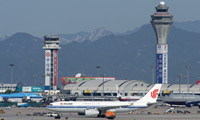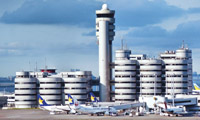Special Report: Asia-Pacific Airports Update
Asia-Pacific airports take to the sky
Asia-Pacific airlines are on the move as the region powers its way to being the world’s biggest air travel market. Airports are determined not to be left behind, forging ahead with major expansion and modernization plans to ensure they can cope with the growing demand.
November 1st 2013
Officials at South Korea’s Incheon Airport recently held a ground-breaking ceremony to mark the start of work on a second terminal that by 2017 will lift passenger capacity by 41% to 62 million.Read More » The $4.6 billion project - a seven-story, 384,000 sq.m terminal the size of 53 soccer fields - is designed to better position Seoul as a major regional hub.
Incheon’s plans are merely the tip of the iceberg as airports across the Asia-Pacific set out on their biggest development splurge for years.
 |
| China to spend more than $250 billion on aerospace sector by 2023 |
Singapore Changi is adding a fourth terminal, also to be completed by 2017, to boost its capacity to 82 million. Plans include a third runway and fifth terminal by the mid-2020s, to take capacity to 130 million passengers a year.
Malaysia is adding a new terminal at Kuala Lumpur International Airport that will open next year to handle 45 million passengers. Hong Kong is planning a third runway at Chek Lap Kok, with an environmental impact study to due for completion in 2014. It handled 56.5 million passengers last year, a number forecast to rise to 102 million by 2030.
Jakarta’s Soekarno-Hatta airport, built for 22 million passengers, handled 57.8 million travellers last year and work has started on an expansion to lift capacity to 62 million. In Bangkok, there are plans to lift capacity at Suvarnabhumi airport from 45 million to 60 million by 2017 and the city’s second airport, Don Muang, which handles low-cost carriers, is being expanded.
From India to Japan, Vietnam to the Philippines, the story is the same.
But it pales against the work going on in China, where 70 new airports are scheduled to be built by 2015 with the total number is projected to reach 244 in 2020, up from 180 at the end of 2011.
“In the 80s, people would say ‘if you want to get rich build a road’,” Civil Aviation Administration of China (CAAC) chief, Li Jiaxiang, said at an industry forum earlier this year. “Nowadays they say ‘if you want to develop, build an airport’.”
More than two-thirds of the worldwide airports under construction are in China, and over the next decade China is expected to spend more than $250 billion on its aerospace sector, according to Research and Markets’ China Aviation Industry Analysis.
The jewel in the Chinese crown, Beijing Capital International Airport, is close to overtaking Hartsfield-Jackson Atlanta International Airport in the US for the title of the world’s largest passenger airport. It handled 81.9 million passengers last year, just ahead of Shanghai’s Pudong and Hongqiao airports with a combined 78.7 million passengers. But even that isn’t enough.
Four years after Beijing Capital’s Terminal 3 opened, the hub has already run out of capacity, and construction began last year on the city’s third airport, in the Daxing district, on the southern outskirts of the capital. It will cover more than 90 square km, have nine runways by 2030 and capacity to handle 130 million passengers.
 |
| Japan plans increase slots at Haneda and Nairita airports to 750,000 by 2014 |
Under China’s 12th Five-Year Plan (2011-2015), 82 airports are scheduled to be built, 16 moved and 91 expanded, increasing the country’s airport network by 50%. The aim is to form a national network that will cover 80% of the population by 2020. By 2015 there will be 264 passenger and cargo airports in China.
But none of this means everything is rosy in China. CAAC director Li admitted at a China Civil Aviation Development Forum in Beijing recently that 134 of its 182 airports run at a loss - about $471 million last year - although he added that the airports contributed more than that to gross national product.
Everyone agrees a major effort is required to meet the growth forecasts. As Andrew Herdman, director general of the Association of Asia Pacific Airlines (AAPA) puts it, regional traffic predictions point to the need for bold construction plans as airports will have to double capacity every 12 years just to keep up. “It’s no good thinking in terms of incremental capacity enhancements of terminals or airports or runways,” he said.
Whatever is happening elsewhere in the world as a result of volatile economic conditions, all the data show air traffic growth in the region remains more than robust. The AAPA’s preliminary figures for August show the region’s operators carried 20.1 million international passengers, up 8.7% on the same month a year ago. While the freight sector remains flat, passenger numbers are rising steadily.
“For Asia-Pacific airlines, international passenger demand has maintained its strong growth trend, with a combined total of 145.5 million during the first eight months of the year, a 5.2% increase compared to the same period last year,” Herdman said. “Underpinned by sustained regional economic growth, we have seen significant increases in both business and leisure travel.”
Similar data from IATA shows Asia-Pacific carriers recorded an increase of 8.6% (the global average was 7.5%) year-on-year in August, the strongest performance among the world’s three biggest regions. Some individual countries are recording much higher rises, particularly for domestic traffic. China’s domestic traffic jumped 13.7% year-on-year in August. Japan enjoyed another month of strong growth, with traffic up 8.8%, as the country’s economy showed signs of steady improvement. Indian domestic traffic surged 15.7%.
Indonesia’s Central Statistics Agency said the number of passengers, domestic and international, reached 6.2 million in August, up 25.57%. “Increases in both domestic and international air passenger numbers reflected our economic activity, which continues to grow, and improved airport infrastructure facilities,” agency head Suryamin said.
In the Philippines, the six key international airports registered a 14% increase in the number of flights in the first half of this year. Growth at some airports has been spectacular. The number of international flights at Clark’s Diosdado Macapagal Airport, now being touted as the second hub after Manila, grew 35.4% in the first half, with passenger numbers up 39%. The Mactan-Cebu International Airport, now home of the country’s major carrier, budget Cebu Pacific, grew a hefty 16.6%, with international passengers up 14%. Despite congestion, Manila’s Ninoy Aquino International Airport still registered a 10% increase in international flights.
Airport Council International (ACI) figures also point to continued strong growth. It says that while global traffic at member airports rose an average 2.9% in the 12 months to August, in Asia-Pacific the increase was 10.2%. (In the other boom region, the Middle East, growth was 18.6%).
The action isn’t all about major hub airports. Several countries are putting an emphasis on attracting airlines to secondary cities. In Vietnam, for instance, international airlines are being encouraged to fly not only to Hanoi and Ho Chi Minh City, but to centres such as Phu Bai, Cam Ranh, Lien Khuong, Can Tho and Phu Quoc international airports. Preferential policies, such as reduced airport charges, are being considered.
“The red carpet is being laid out to welcome all airlines to Hue, Nha Trang, Da Lat, Can Tho and Phu Quoc,” Vo Huy Cuong, deputy head of the Civil Aviation Administration of Vietnam, said at a recent conference. “Operations to and from these airports show that the aviation market in these areas is soaring. The load factors are very high, over 80%, with that on the flights to Phu Quoc reaching 90%.”
He said there would be no capacity limitation on third, fourth and fifth traffic freedom rights, even on seventh traffic rights, for all cargo services. “All co-operative arrangement forms, including joint ventures, code-sharing and all types of operations including passenger/cargo scheduled and non-scheduled services will be allowed. The government will create a flexible policy for air navigation service charges and airport charges suitable for airlines operating at these five airports.”
In Japan too, unprecedented measures are being taken to increase capacity. The transport ministry says it will consider expanding slots at the two main airports in the Tokyo area – Narita and Haneda - to cover expected growth in demand following the successful bid to host the 2020 Olympics. The ministry plans to increase the [of departure and landing slots at the two airports to 750,000 a year as soon as fiscal 2014,] compared with the maximum 680,000 now, and it is convening a panel of academics and experts to discuss measures to boost the slots further.
Among the possibilities are building a new runway at Haneda and narrowing the time between incoming and outgoing flights by allowing planes to fly over central Tokyo. This is now banned due to safety concerns.
Whether all of this will ultimately be enough, only time will tell. But governments and airports are well aware of infrastructure needs. Boeing estimates airlines in the region will need 12,030 new aircraft, valued at $1.7 trillion, over the next 20 years, taking the regional fleet from 4,710 aircraft in 2011 to 13,670 in 2031.
John Leahy, chief operating officer (customers) for Airbus, said recently that over the next 20 years the region’s airlines will buy about 9,870 passenger and cargo planes valued at $1.6 trillion. “This represents 35 percent of all new aircraft deliveries worldwide over the next 20 years, ahead of Europe and North America. In terms of value, the region will account for 40% of the global market for new airliners,” he said.
Coping with all these new planes will be a challenge, and failure to do so will have repercussions. As Albert Tjoeng, assistant director for corporate communications at IATA’s office in Singapore, said recently, the problem is “that when the infrastructure is not able to meet the demand, airlines and their passengers will end up experiencing delays, both for arrivals and for departures”. “If airlines are unable to expand due to lack of infrastructure, it will have an impact on tourism and the economic benefits that aviation and tourism can bring to the local economy,” he said.